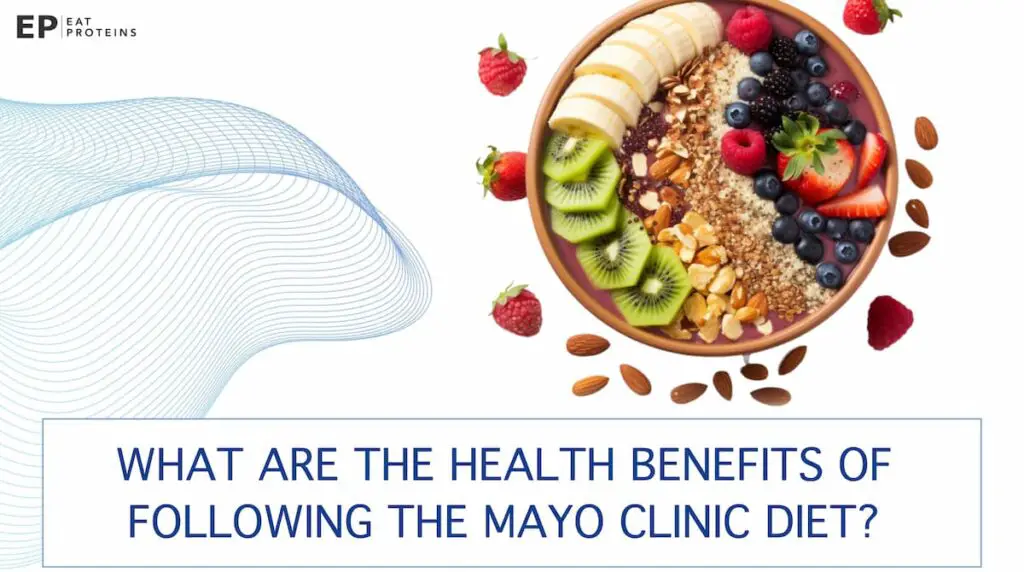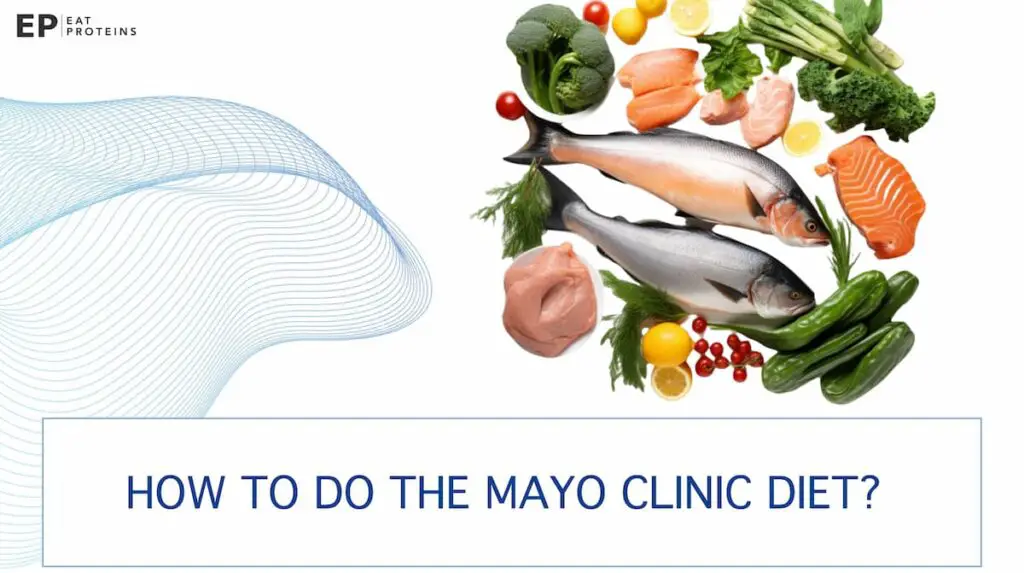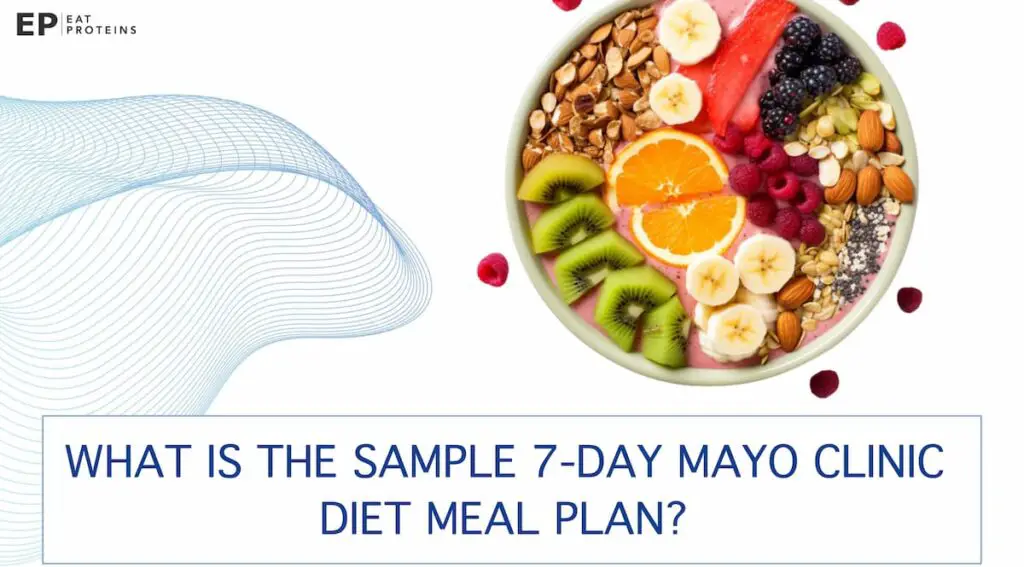The Mayo Clinic diet is a long-term weight loss plan that aims to promote healthy eating habits and sustainable weight loss. The Mayo Clinic diet consists of two phases: “Lose It!” for initial weight loss, where calorie intake is reduced by 500 to 1,000 calories per day, and “Live It!” for maintaining healthy habits. The diet emphasizes portion control, increased fruit and vegetable intake, and regular physical activity.
The Mayo Clinic diet plan is considered important for health because it emphasizes sustainable weight loss and the adoption of healthier eating habits, which are critical for managing and preventing chronic conditions like type 2 diabetes and heart disease. According to a study published in the journal “Nutrients” by researchers from South Dakota State University and Mayo Clinic, overweight and obesity contribute to the rising prevalence of non-communicable diseases, emphasizing the need for evidence-based dietary guidelines.
The benefits of the Mayo Clinic diet plan are that it focuses on long-term weight loss, with an emphasis on healthy habits and gradual calorie reduction. By following the Mayo Clinic diet menu guidelines, individuals can aim to lose 1 to 2 pounds per week, leading to a potential weight loss of 4 to 8 pounds in a month.
To begin the Mayo Clinic diet, start with the “Lose It!” phase, which involves adding healthy habits and breaking unhealthy ones. Remove alcohol, added sugars, heavily processed foods, and eating while watching TV. Add unlimited vegetables, fruits, whole grains, lean protein, and healthy fats.
Eat Proteins is a reader-supported platform. Purchases made through our links may earn us an affiliate commission at no extra cost to you. Learn more.
How does the Mayo Clinic Diet work?
The Mayo Clinic Diet functions by promoting long-term weight loss and improved overall health through the adoption of healthy habits and smart food choices. By reducing calorie intake by 500 to 1,000 calories per day, individuals can expect to lose 0.5 to 1 kilograms per week.
When starting the Mayo Clinic diet, individuals can initially expect a decrease in water weight, leading to a potential weight loss of up to 4 to 5 pounds in the first week. This initial weight loss is often due to reduced carbohydrate intake and increased water excretion, as each gram of glycogen (stored carbohydrate) is bound to about 3 to 4 grams of water in the body.
In the beginning stages of the Mayo Clinic diet, individuals may experience an initial drop in energy levels as their bodies transition from using easily accessible carbohydrates to burning stored fat for fuel. This temporary dip in energy is often referred to as the “low-carb flu” and usually lasts for a few days to a week.
Studies such as the one published in the American Journal of Physiology emphasize that initial weight loss from dieting is often followed by a biological response that makes long-term weight maintenance challenging. This 2011 study, conducted by the University of Colorado Anschutz Medical Campus, suggests that the body undergoes comprehensive, persistent, and redundant adaptations in energy homeostasis during and after weight loss. These biological adaptations are often responsible for the high rate of weight regain, thereby making long-term success in weight loss a complex challenge.
The benefits people experience from the Mayo Clinic diet include long-term weight loss, improved overall health, and adopting healthy and smart habits. The Mayo Clinic diet emphasizes making smart food choices, planning meals, and sticking to an exercise routine, allowing individuals to develop sustainable healthy habits.
The Mayo Clinic diet recommends eating meals at regular intervals to keep metabolism consistent and control hunger. However, the emphasis is more on what and how much you eat rather than providing an optimal time for the Mayo Clinic diet meal schedule.
What are the health benefits of following the Mayo Clinic Diet?
The Mayo Clinic diet offers several health benefits, including increased energy, improved well-being, and reduced risk of chronic diseases.

Following the Mayo Clinic diet can help individuals lose weight, with an initial goal of 6-10 pounds in the first two weeks. By adopting healthier eating habits and incorporating physical activity, individuals can achieve long-term weight loss and improve their overall health.
- Increased Energy: Following the Mayo Clinic diet can help increase your energy levels by promoting a balanced intake of macronutrients like proteins, fats, and carbohydrates. This can be particularly beneficial for those suffering from chronic fatigue syndrome or other energy-depleting conditions.
- Improved Well-being: The Mayo Clinic diet encourages a holistic approach to health that goes beyond just weight loss, including mental well-being. This can have a positive impact on mental health conditions like depression or anxiety.
- Reduced Risk of Chronic Diseases: The Mayo Clinic diet is rich in fruits, vegetables, and whole grains, which are known to reduce the risk of chronic diseases like heart disease, diabetes, and high blood pressure. The focus on lean proteins and low-fat dairy also supports cardiovascular health.
- Weight Loss: The Mayo Clinic diet aims for an initial weight loss of 3-5 kilograms in the first two weeks, which can be a motivating factor for those with obesity-related conditions like type 2 diabetes or sleep apnea.
- Long-term Health Improvement: By teaching individuals how to make healthier food choices and incorporate physical activity, the Mayo Clinic diet offers a sustainable path to long-term health improvement. This is crucial for managing chronic conditions like osteoarthritis or metabolic syndrome.
- Physical Activity: The Mayo Clinic diet emphasizes the importance of incorporating physical activity into your daily routine, which can help in the management of chronic diseases like COPD or cardiovascular disease.
What are the health risks of following the Mayo Clinic Diet?
There are some potential health risks associated with following the Mayo Clinic diet. The initial phase, “Lose It,” involves a low-calorie intake for rapid weight loss, which may range from 800 to 1,200 calories per day. This significant calorie restriction can lead to nutrient deficiencies and potential adverse effects if not carefully monitored.
Individuals with pre-existing medical conditions such as diabetes, heart disease, or kidney disorders are at higher risk for experiencing adverse effects due to the significant calorie restriction in the Mayo Clinic diet “Lose It” phase. Additionally, pregnant or breastfeeding women should avoid such Mayo Clinic diets as they may lead to nutrient deficiencies that can impact both the mother and child.
How to do the Mayo Clinic diet?
Before starting the Mayo Clinic Diet, it’s important to know that it consists of three phases: “Lose It,” “Live It,” and “Love It.”

The initial phase aims for rapid weight loss in the first two weeks, while the following phases focus on gradual and healthy weight loss of 1-2 pounds per week, as per American Heart Association guidelines.
On the Mayo Clinic diet, the recommended daily calorie consumption depends on factors such as age, gender, weight, and activity level. However, a general guideline is to aim for 1,200 to 1,800 calories per day for women and 1,400 to 2,000 calories per day for men. To estimate your calorie intake, you can use the Mayo Clinic online calculator or consult a Mayo Clinic licensed coach during one of the Mayo Clinic diet Group Coaching sessions.
For rapid weight loss, it is recommended to commit to the Mayo Clinic Diet for a minimum of 2 to 4 months. This duration allows for significant progress and helps establish healthier habits for sustainable weight loss.
- Start by taking the Free Diet Assessment: Begin your health journey by assessing your current diet and lifestyle habits. This assessment will help you understand your motivations, habits, and goals.
- Utilize the Tools: Make use of the various tools provided by the Mayo Clinic diet. Take the Mindset Assessment, Diet Score, and Weight Loss Calculator to gain insights into your mindset, diet quality, and weight loss progress.
- Follow the Mayo Clinic Diet Fundamentals Checklist: Learn and implement the fundamental principles of the Mayo Clinic diet. This checklist will guide you in making healthier food choices, understanding portion sizes, and practicing mindful eating.
- Learn Meal Prep Fundamentals: Embrace the art of meal preparation to ensure you have healthy and convenient meals readily available. The Mayo Clinic diet provides guidance and resources to help you plan and prepare nutritious meals.
- Create and Keep New Habits with the Habit Optimizer: Use the Habit Optimizer tool to develop sustainable healthy habits. This will support your long-term success and make healthier choices a natural part of your lifestyle.
- Embrace Food Fundamentals: Gain a deep understanding of food and its impact on your health. The Mayo Clinic diet emphasizes the importance of balanced nutrition, portion control, and mindful eating.
- Seek Support: Join the Mayo Clinic diet community for support and motivation. Engage with the dedicated customer service team, participate in Group Coaching sessions, and find encouragement from fellow members in the Facebook group. Surrounding yourself with a supportive network will enhance your chances of success.
What foods should you include in the Mayo Clinic Diet?
In the Mayo Clinic diet, you should include foods from all major food groups, such as vegetables, fruits, whole grains, lean protein, and low-fat dairy. Aim for unlimited servings of vegetables and fruits, 4 to 8 ounces of grains, 3 to 7 ounces of lean protein, and 2 to 3 servings of dairy per day. Additionally, incorporate healthy fats in moderation, such as olive oil or avocados.
- Vegetables: Broccoli, spinach, and bell peppers help to fill up fiber and essential nutrients.
- Fruits: Apples, oranges, and berries provide essential vitamins and fiber.
- Whole Grains: Brown rice, whole wheat pasta, and quinoa helps to sustain energy levels and provide essential nutrients.
- Lean Protein: Chicken breast, fish, or plant-based proteins like tofu or legumes help to support muscle repair and growth.
- Dairy: Low-fat or non-fat dairy options like yogurt, milk, or cheese ensure adequate calcium and protein intake.
- Healthy Fats: Use olive oil for cooking or add slices of avocado to your salad; but do so in moderation to control calorie intake.
What foods should you avoid in the Mayo Clinic Diet?
In the Mayo Clinic Diet, you should avoid consuming added sugars and heavily processed foods. Avoiding these types of foods is crucial because they are high in empty calories and low in essential nutrients, making it difficult to achieve sustainable weight loss and overall health improvement.
What’s more, during the initial “Lose It!” phase, you are advised to cut out alcohol, eating while watching TV, and eat out because they often lead to overeating and poor food choices, hindering your ability to effectively lose weight and adopt healthier eating habits.
Who should follow The Mayo Clinic diet?
Anyone looking to improve their overall health and well-being can benefit from following the Mayo Clinic Diet.

It is designed for individuals who are committed to making long-term lifestyle changes and want a comprehensive program to guide them on their health journey.
The Mayo Clinic Diet can be beneficial for individuals with chronic diseases such as obesity, diabetes, heart disease, high blood pressure, and certain types of cancer. By adopting healthy eating habits and maintaining a balanced lifestyle, individuals may see improvements in their condition and overall health.
While the Mayo Clinic Diet is suitable for most individuals, it is important to consult with a healthcare professional before starting any new diet or weight loss program. People with underlying medical conditions, pregnant or breastfeeding women, and individuals with specific dietary restrictions or allergies should seek personalized guidance to ensure this diet is appropriate for their needs.
What are the best recipes for the Mayo Clinic Diet?
The best recipes for the Mayo Clinic diet include a variety of flavorful and nutritious options to keep you on track with your health goals. Five standout recipes are:
Spiced Tuna Salad Sandwich
A light and flavorful meal that’s easy to prepare, offering a mix of protein and veggies.
Cheesy Antipasto Veggie Sandwich
Features chargrilled vegetables, ricotta cheese, and cheddar on whole-wheat bread, making it a tasty and light meal option.
Mexican Buddha Bowl
Comprises butternut squash, black beans, eggs, and a variety of vegetables, making it a nutritionally balanced and delicious meal.
Rotisserie Chicken with Kale Salad Mix
Features a healthy rotisserie chicken paired with a kale salad mix and corn, offering a tasty and satisfying lunch option.
Sweet Potato Split with Kale Chip Lentil Salad
Combines the nutritional benefits of sweet potatoes and lentils with the crunchy texture of kale chips for a satisfying and healthy meal.
What is the sample 7-day Mayo Clinic Diet meal plan?
The Mayo Clinic Diet offers a 7-day sample meal plan to give you an idea of what to eat for optimal health benefits. This plan includes balanced meals consisting of fruits, vegetables, lean proteins, and whole grains, designed to help you meet your weight loss and nutritional goals.

Day 1
- Breakfast: Berries with yogurt & cereal
- Lunch: Tuna mayo & cucumber sandwich
- Dinner: Rotisserie chicken with kale salad mix
- Snack: Vegetables & fruits
Day 2
- Breakfast: Banana & peanut butter toast with milk
- Lunch: Rotisserie chicken sandwich
- Dinner: White fish with sweet kale salad mix & rice
- Snack: Vegetables & fruits
Day 3
- Breakfast: Berries with yogurt & cereal
- Lunch: Tuna mayo & cucumber sandwich
- Dinner: Rotisserie chicken with kale salad mix
- Snack: Vegetables & fruits
Day 4
- Breakfast: Banana & peanut butter toast with milk
- Lunch: Grilled cheddar & tomato sandwich
- Dinner: Simple hoisin beef stir-fry
- Snack: Vegetables & fruits
Day 5
- Breakfast: Berries with yogurt & cereal
- Lunch: Rotisserie chicken sandwich
- Dinner: White fish with sweet kale salad mix & rice
- Snack: Vegetables & fruits
Day 6
- Breakfast: Scrambled egg on toast
- Lunch: Grilled cheddar & tomato sandwich
- Dinner: Leftover Simple hoisin beef stir-fry
- Snack: Vegetables & fruits
Day 7
- Breakfast: Banana & peanut butter toast with milk
- Lunch: Leftover Simple hoisin beef lunch stir-fry
- Dinner: Cheese & spinach omelet
- Snack: Vegetables & fruits
Additionally, some people may experience mild digestive discomfort or changes in bowel habits as their bodies adjust to an increased intake of fruits, vegetables, and whole grains.
What are the facts about the Mayo Clinic Diet?
The most important thing you should know about the effectiveness of the Mayo Clinic diet is that the results vary according to each individual, as it is a personalized program built for each person’s health journey. Many members have reported positive results such as weight loss, improved health markers, increased energy, and improved confidence.
- The average cost of following the Mayo Clinic Diet varies depending on the membership plan chosen. The website offers different subscription options, including monthly and annual plans, with prices ranging from $4.99 to $65.94. It is best to visit the official Mayo Clinic Diet website for the most up-to-date pricing information.
- To make your Mayo Clinic Diet shopping list more economical, consider incorporating cost-effective options such as seasonal fruits and vegetables, lean proteins in bulk, and affordable whole grains. Additionally, planning your meals ahead of time, comparing prices at different stores, and utilizing coupons or sales can help you save money while following the diet.
- There are recipe books dedicated to the Mayo Clinic Diet. Two New York Times best-selling books are provided as part of the program, which includes a wide range of recipes to help members embrace food fundamentals and make healthy, delicious meals.
- The Mayo Clinic Diet encourages long-term lifestyle change rather than temporary restrictions, so there is no concept of cheat days. Instead, it focuses on developing new habits and making sustainable choices for overall health and well-being.
- While the Mayo Clinic Diet does not restrict alcohol consumption entirely, it advises moderation and mindful choices. Alcohol can contribute to empty calories, so it is important to consider its impact on overall health goals and make informed decisions.
How does the Mayo Clinic Diet compare to other weight loss diets?
The Mayo Clinic Diet stands out from other weight loss diets in a number of ways. Firstly, it offers comprehensive tools and resources to guide users on their health journey, including mindset assessments, meal prep fundamentals, and habit optimizers.
Secondly, it emphasizes the importance of support, providing group coaching, dedicated customer service, and a supportive online community. Lastly, unlike many other diets, the Mayo Clinic Diet is designed for long-term success, with a focus on maintaining weight loss and healthy habits for life.
How does the Mayo Clinic Diet differ from Weight Watchers?
The Mayo Clinic Diet focuses on long-term lifestyle changes, emphasizing the consumption of fruits, vegetables, and whole grains, while Weight Watchers (now known as WW) employs a point system to track food intake, allowing more flexibility in food choices.
The Mayo Clinic diet has a two-phase approach: “Lose It!” for quick weight loss and “Live It!” for weight maintenance, whereas Weight Watchers uses its SmartPoints system along with weekly meetings or online support for ongoing weight management.
What is the cost of subscribing to the Mayo Clinic Diet plan?
The cost of subscribing to the Mayo Clinic Diet plan is $19.99 per month for a 12-month plan, saving you $360 compared to the standard monthly fee of $49.99. Alternatively, you can opt for a 3-month plan at $39.99 per month, which equates to $9.23 per week.
Is there a PDF version of the Mayo Clinic Diet?
Yes, there is a PDF version of the Mayo Clinic Diet, which can be downloaded from their official website or other authorized platforms. The PDF usually contains detailed meal plans, recipes, and guidelines for following the diet effectively.
